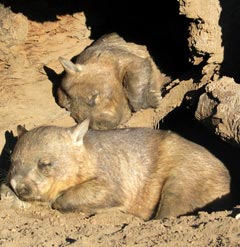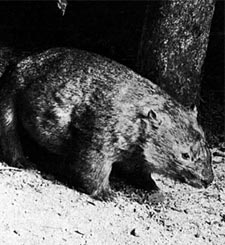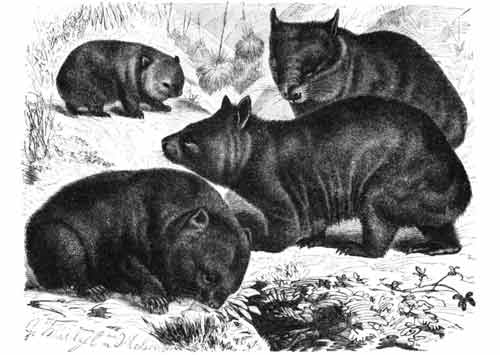
Master Architects: Wombats dig extensive burrow systems with rodent-like front teeth and powerful claws. Although mainly crepuscular and nocturnal, wombats will also venture out to feed on cool or overcast days.
 Cubic Scats: They are not as easily seen as many animals, but leave ample evidence of their passage, treating fences as a minor inconvenience to be gone through or under and leaving distinctive cubic scats. Wombats are herbivores, their diet consisting mostly of grasses, sedges, herbs, bark and roots. Cubic Scats: They are not as easily seen as many animals, but leave ample evidence of their passage, treating fences as a minor inconvenience to be gone through or under and leaving distinctive cubic scats. Wombats are herbivores, their diet consisting mostly of grasses, sedges, herbs, bark and roots.
Fast as Lightning: Wombats have an extraordinarily slow metabolism, taking around 14 days to complete digestion, and generally move slowly. When required, however, they can reach up to 40 km/h and maintain that speed for up to 90 seconds.
Attack and Defend: When attacked, they can summon immense reserves of strength — one defense of a wombat against a predator (such as a Dingo) underground is to crush it against the roof of the tunnel until it stops breathing. Its primary defence is its toughened rear hide with most of the posterior made of cartilage which, combined with its lack of a meaningful tail, presents a difficult-to-bite target to any enemy who follows the wombat into its tunnel. One naturalist commented, that a predator biting into a wombat's rear would find it "comparable to the business end of a toilet brush".
 Little Fear of Humans: Unlike a lot of Australian marsupial wildlife, wombats appear to have little fear of humans. Little Fear of Humans: Unlike a lot of Australian marsupial wildlife, wombats appear to have little fear of humans.
They can be awkwardly tamed in a captive situation, and even coaxed to be patted and held. Many parks, zoos and
other tourist set-ups across Australia have wombats for show to the public. They
are quite popular in the zoos they are present in.
Don't Get Too Close: However, this lack of fear also means that they may display acts of aggression if provoked, or if they are simply in a bad mood.
Charging Wombat: Its sheer weight makes a charging wombat capable of knocking a man over, and their sharp teeth and powerful jaws can result in severe wounds. The naturalist Harry Frauca once received a bite 2 cm deep into the flesh of his leg—through a rubber boot, trousers and thick woollen socks (Underhill, 1993). A young boy let into an enclosure unprotected to feed a wombat at a caravan park was charged, knocked over, and bitten and scratched all over.
Solitary Animals: Wombats, while they look cute and cuddly when small, do not make good pets in the long run. They are solitary animals and prefer to stay that way when older.
Unfortunately many people's only contact with wombats is on highways at night, when many are killed in accidents, often doing considerable damage to vehicles.

Wombat Evolution: Wombats, like all the larger living marsupials, are part of the Diprotodontia. The ancestors of modern wombats evolved sometime between 55 and 26 million years ago (no useful fossil record has yet been found for this period) and about 12 species flourished until well into the ice ages. Among the several diprotodon (giant wombat) species was the largest marsupial to ever live. The earliest human inhabitants of Australia arrived while diprotodons were still common, and are believed to have brought about their extinction through hunting or habitat alteration

All text is available under the terms
of the GNU Free Documentation License
|